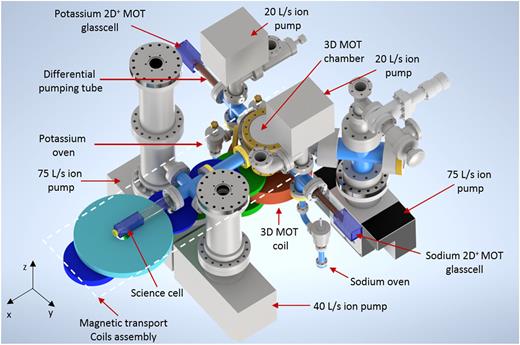RRI’s indigenously developed experimental facility to help deepen knowledge in quantum technologies
[Posted on 14 July 2023]

Scientists at the Raman Research Institute (RRI) have indigenously built an experimental facility to simultaneously cool and trap a large number of sodium and potassium atoms near absolute zero temperatures using laser light and magnetic fields.
With this, RRI, an autonomous institute funded by the Department of Science and Technology, Government of India, has joined the handful of laboratories globally to demonstrate such efficient simultaneous production of a mixture of two species of ultra-cold neutral atoms with inter-species interactions control.
Results from this experiment can deepen the knowledge required for developing quantum technologies such as quantum computing, quantum sensing and metrology -- all of which are the frontier areas of research.
Built over a period of five years, this specialised experimental facility comprises four interconnected ultra-high vacuum chambers, where atoms are trapped and cooled under a pressure to the tune of 10-11 millibar (equal to 14 orders lower than the normal atmospheric pressure). There are multiple intricate Laser systems, optical arrangements and high-resolution detections systems. Using techniques of flashing light onto the atoms, the researchers said that it was possible to manipulate properties of atoms and use it for taking various measurements that are fundamentally quantum mechanical in nature.
" Using a combination of light and magnetic field, we attempted to cool and trap a large number of sodium and potassium atoms from their mixture at near absolute zero temperature (in micro Kelvin). As the behaviour of atoms is different at such low temperatures in comparison to the atoms at room temperatures, we wanted to understand their quantum co-relations," said Saptarishi Chaudhuri from the Quantum Mixtures Laboratory (QuMix), who led the latest experimental research.
In the absolute ground state, dipolar molecules of sodium and potassium possess high dipole moments, hence they offer high versatility to the researchers to study the many body physics, perform tests for quantum simulation, sensing and entanglement.
" The advantage of the experiment setup is that the properties of these atoms are highly controllable. We can swiftly change many parameters without the need to produce newer samples, as is the case in most condensed matter system experiments," explained Sanjukta Roy, co-author of the study published in the journal AIP Advances, where it has bagged the distinction of being Editor’s Pick article.
Being natural qubits, both sodium and potassium can be subjected to manipulation using tailored light. These then can be excited to any desired state as required for the experiment. The sodium-potassium mixture was used primarily because they offer a perfect combination of Fermionic (heavy in weight) and Bosonic (light in weight) properties for studies under light. Resonant light was flashed to achieve the quantum state control of atoms, said Gourab Pal, a PhD student, who co-authored the article.
According to Sagar Sutradhar, a final-year PhD student and article’s lead author, the experiment setup includes another trap at the pre-cooling stage known as a cold atomic beam.
“ It is based on the idea of two-dimensional magneto-optical trapping of atoms. This vital intervention was introduced to first cool the atoms and later push them into the main experimental setup,” said Sutradhar, who designed, implemented and characterized the performance of the system.
As a result, the researchers succeeded to trap 1,000 times greater number of atoms compared to the traditional atom traps used in various laboratories worldwide. To be precise, the special experimental setup typically manages to trap 10 billion potassium atoms and about 50 million sodium atoms in the mixture.
Anirban Misra, another co-author of the paper, said, “ The simultaneous production of high-power narrow line-width laser light and frequency, intensity, polarization and phase control of these trapping lights is one of most complex yet necessary steps required for successfully cooling such large numbers of atoms.”
Sayari Majumder, who also contributed in this work, noted, “ These ultra-cold atoms, especially in the form of a mixture, are ideal candidates for quantum sensing of tiny magnetic fields. The interspecies interaction as reported in the paper is now being utilized to develop better sensitivity quantum magnetometer in the laboratory.”
On the observed behaviour near absolute zero temperatures, Chaudhuri said, “ As the atoms are inherently quantum mechanical in nature, they do not collide during their inter and intra-atomic interactions. Instead, they move at rates of a few millimetre/second, and this helps us to study light-assisted interactions between the atoms.”
Link to the article - https://doi.org/10.1063/5.0154985
DOI: 10.1063/5.0154985
For more details, write to Saptarishi Chaudhuri - srishic@rri.res.in